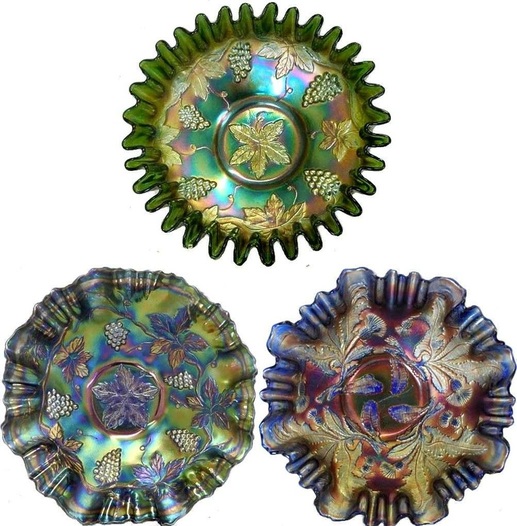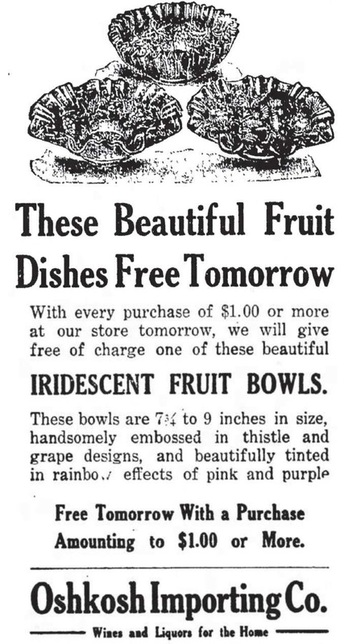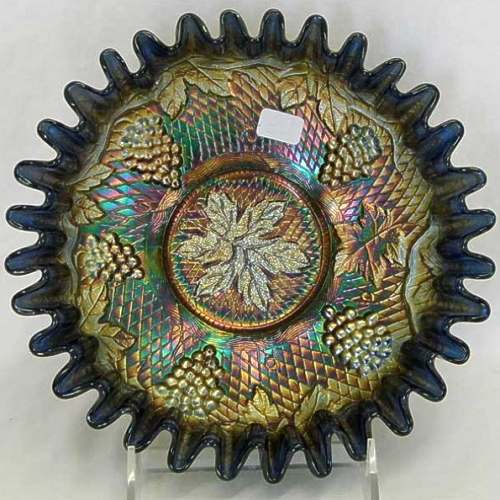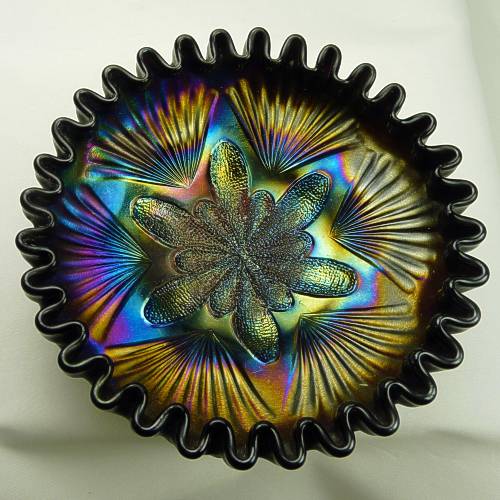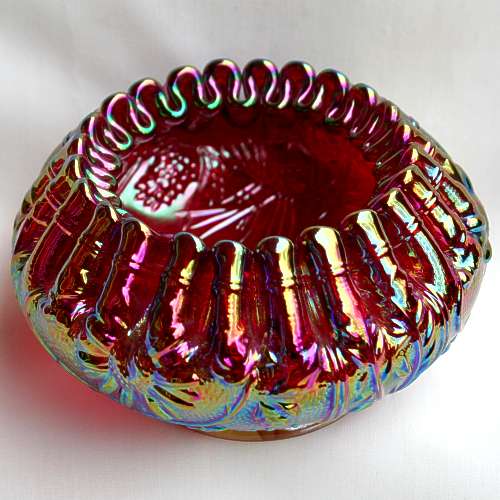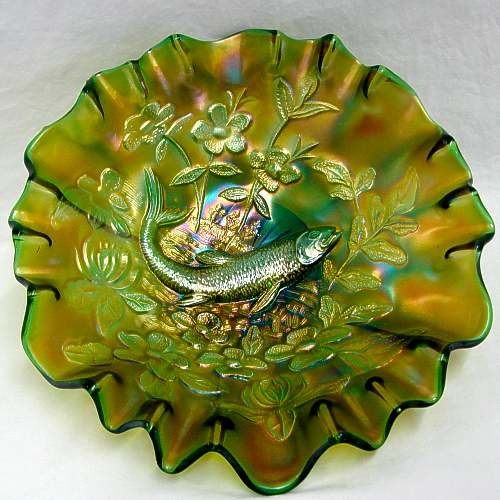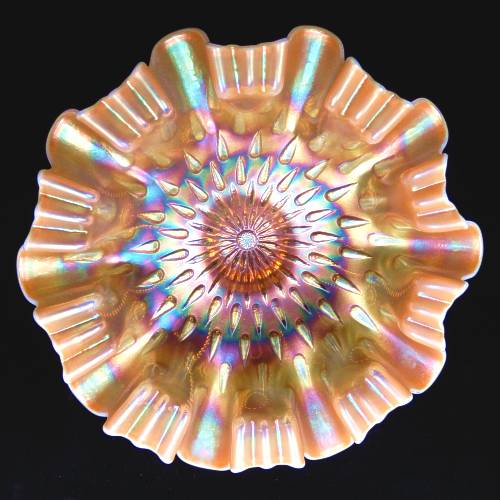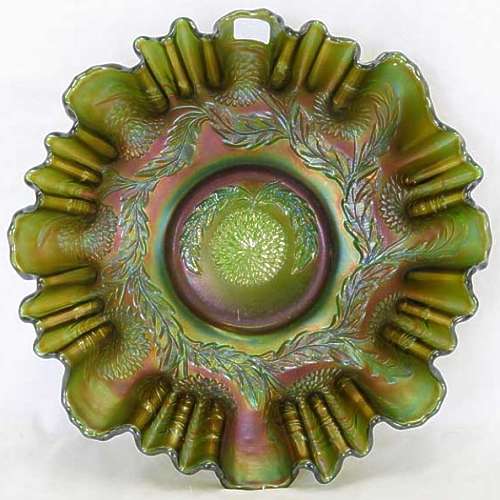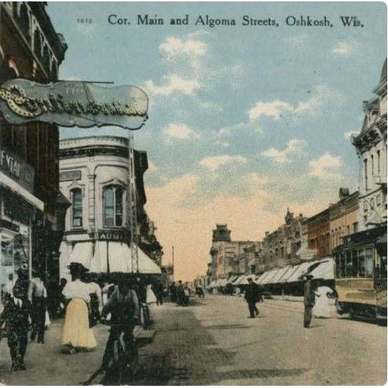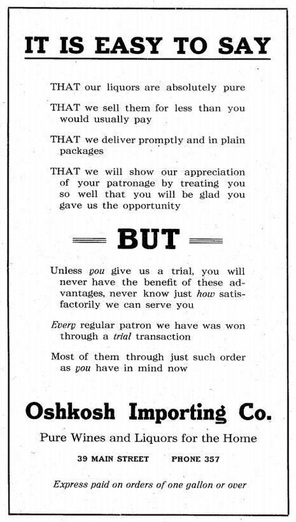B’Gosh … Carnival from Oshkosh
|
The splendid ad shown on the right for the Oshkosh Importing Company was shown in the “Wisconsin Daily Northwestern” newspaper in 1911. The three bowls illustrated are all by Fenton, and the image in the ad is recreated below. Clockwise from the top they are: green Vintage, with a candy ribbon edge (aka fine crimp or tight crimp); blue Thistle, with a three-in-one edge; green Vintage, with a three-in-one edge. |
Edge Treatment – extracts from our book “The Art of Carnival Glass” (2004, published by Schiffer Books).
The Classic Carnival Glass makers were very creative when it came to maximising the use of a particular mould (moulds were expensive, and it made economic sense to use them as much as possible). When the glass was being hand finished, the pieces could be made to look far more individual by using various different edge treatments. The ones shown in the ad were Candy Ribbon Edge and Three in One Edge, as described below.
Candy Ribbon Edge (CRE), also called Fine Crimped Edge, Tight Crimped Edge (TCE) and Continuous Crimping.
A splendid edge where the tight sinuous curves belie the fragile brittleness of the glass. Examples may be further ruffled to give a complex effect. 32 tight regular crimps appear to be the standard number on 8 inch bowls. Only a handful of patterns can be found with this edge shaping - Fenton and Dugan made possibly the greater number of examples in this unusual treatment, but Millersburg pieces are also known (although they usually exhibit a looser, less tight crimp). Bowls shaped in this way are usually found in regular round shapes, but rare examples are known squared and tricorner.
The Fenton Art Glass Company used an apparatus known as the crimp to produce what they called the Tight Crimped Edge, right up to its closure in 2011.
Three in One (3 in 1)
Two small dips or ruffles and then one larger dip characterise the fancy edge often called Three in One or Three and One. Frank M. Fenton informed us that he prefers to call this edge Two and One, as that is more descriptive and accurate. When the edge shaping was first introduced, Fenton actually referred to the shaping as the Fruit Crimp. Dugan, Fenton and Millersburg used this distinctive edge shaping - the Dugan version tends to have much deeper dips.
There are some scarce examples of Northwood 3 in 1 edges. It seems most likely that these were early Northwood items and carried over from the pre-Carnival era. Northwood appears to have abandoned this edge technique in favour of their pie crust edge.
Three in One (3 in 1)
Two small dips or ruffles and then one larger dip characterise the fancy edge often called Three in One or Three and One. Frank M. Fenton informed us that he prefers to call this edge Two and One, as that is more descriptive and accurate. When the edge shaping was first introduced, Fenton actually referred to the shaping as the Fruit Crimp. Dugan, Fenton and Millersburg used this distinctive edge shaping - the Dugan version tends to have much deeper dips.
There are some scarce examples of Northwood 3 in 1 edges. It seems most likely that these were early Northwood items and carried over from the pre-Carnival era. Northwood appears to have abandoned this edge technique in favour of their pie crust edge.
Above: Differing styles of 3 in 1 edges from Millersburg, Dugan and Fenton
|
Another ad from the Oshkosh Importing Company had appeared in a 1910 Gazetteer. Shown on the right, it’s fascinating to see how this company promoted their wine and liquor business, especially that the liquor would be delivered discretely "in plain packages". Below is a picture of Main Street, Oshkosh, around 1911. |
